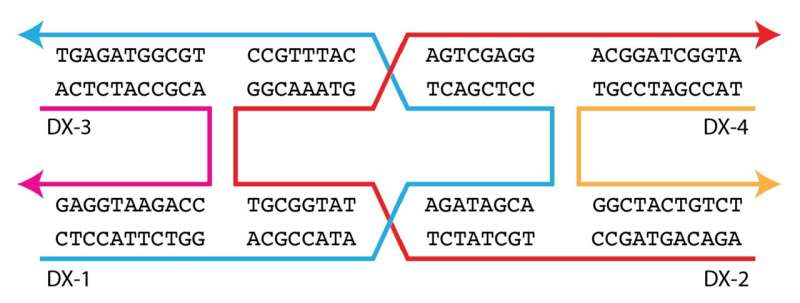This article has been reviewed according to Science X's editorial process and policies. Editors have highlighted the following attributes while ensuring the content's credibility:
fact-checked
peer-reviewed publication
trusted source
proofread
Researchers advance DNA nanostructure stability

Researchers at the University at Albany's RNA Institute have demonstrated a new approach to DNA nanostructure assembly that does not require magnesium. The method improves the biostability of the structures, making them more useful and reliable in a range of applications. The work appears in the journal Small this month.
When we think of DNA, the first association that comes to mind is likely genetics—the double helix structure within cells that houses an organism's blueprint for growth and reproduction. A rapidly evolving area of DNA research is that of DNA nanostructures—synthetic molecules made up of the same building blocks as the DNA found in living cells, which are being engineered to solve critical challenges in applications ranging from medical diagnostics and drug delivery to materials science and data storage.
"In this work, we assembled DNA nanostructures without using magnesium, which is typically used in this process but comes with challenges that ultimately reduce the utility of the nanostructures that are produced," said Arun Richard Chandrasekaran, corresponding author of the study and senior research scientist at the RNA Institute.
"For example, magnesium can cause DNA nanoparticles to clump together, which alters the characteristics of the drug being delivered. This can interfere with drug loading in the body, ultimately reducing the drug's efficacy. Magnesium can also enhance the activity of enzymes in the body that degrade DNA, thus reducing the lifespan of the nanostructures in the body."
The research team, which included scientists at the University of Illinois Urbana-Champaign, assembled four types of DNA nanostructures in six different metal ions including calcium, barium, sodium, potassium and lithium, as well as magnesium.
"We found that DNA nanostructures assembled in monovalent ions (sodium, potassium, lithium) are much more biostable compared to those assembled in divalent ions (magnesium and calcium)," said Chandrasekaran.
"We demonstrated the wide applicability of our findings by assembling four types of DNA nanostructures of different complexities and sizes using these different ions. These ranged from small DNA motifs such as the double crossover motif and the three-point-star motif to larger assemblies such as a DNA tetrahedron and a DNA origami triangle."
"Assembly of structures that can withstand degradation by nucleases, such as those we've assembled here, would be useful in biological applications such as in drug delivery where DNA nanostructures used as drug carriers need to be intact until they deliver the drug at the target sites."
"Our work focuses on identifying conditions that can be used to build effective drug delivery systems," said Arlin Rodriguez, first author of the study and a research support specialist in Chandrasekaran's lab at the RNA Institute.
"One important aspect highlighted in this study is the resistance of nanostructures assembled in monovalent ions against nuclease degradation, which is useful in preventing damage to these structures in the presence of a nuclease. This improvement in nanostructure durability can help optimize drug release in the body."
"Magnesium has traditionally been the primary ion employed in the assembly of DNA nanostructures," said co-first author Dhanush Gandavadi, a Ph.D. student at the University of Illinois Urbana-Champaign. "However, by restricting ourselves solely to magnesium, we have overlooked possibilities for assembling DNA nanostructures using alternative ions."
"Our study expands the horizons of DNA nanostructure design and facilitates the development of superior drug delivery systems by exploring diverse ions," said co-corresponding author Xing Wang, a bioengineering and chemistry faculty member at the University of Illinois Urbana-Champaign.
"Furthermore, our study sheds light on the influence of various ions on the stability and compactness of DNA origami nanostructures, thereby widening our understanding of their fundamental properties."
Next, the team plans to further optimize nanostructure assembly in a variety of metal ions for higher assembly yields, and to test the biostability of structures assembled in the absence of magnesium within cells.
More information: Arlin Rodriguez et al, Self‐Assembly of DNA Nanostructures in Different Cations, Small (2023). DOI: 10.1002/smll.202300040
Journal information: Small
Provided by University at Albany





















